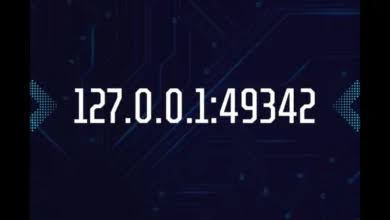Understanding 127.0.0.1:49342: A Guide to Localhost and Port Usage

In the world of networking, terms like 127.0.0.1 and 49342 often pop up, especially for those dealing with local servers or software development environments. While these may seem like random numbers at first glance, they actually hold significant meaning in the realm of IP addresses and port management. Let’s break down what 127.0.0.1:49342 really means and why it is important.
What is 127.0.0.1?
127.0.0.1 is the loopback address commonly referred to as localhost. In networking, the loopback address is used to establish an IP connection to the same machine or computer that is making the request. In simpler terms, if you’re working on your own machine and want to test a network service, using 127.0.0.1 allows you to send data packets back to your own system.
- Why is it important?
Developers often use 127.0.0.1 to run and test applications locally without affecting external networks. For example, web developers might use this address to test websites on their own computers before deploying them to public servers. - Loopback Range:
While 127.0.0.1 is the most commonly used loopback address, the entire range from 127.0.0.0 to 127.255.255.255 is reserved for loopback purposes.
Understanding Port 49342
The 49342 part of “127.0.0.1:49342” refers to a port number. Port numbers allow a computer to differentiate between different services or processes. Each network service running on a machine communicates through a specific port number. These port numbers range from 0 to 65535, divided into different categories:
- Well-known Ports (0-1023): Reserved for common services like HTTP (port 80), HTTPS (port 443), FTP, and others.
- Registered Ports (1024-49151): Used by user-installed applications.
- Dynamic/Private Ports (49152-65535): These are used dynamically by client applications, like in our example.
In the case of 127.0.0.1:49342, the port 49342 is in the dynamic/private range. This means it’s likely being used temporarily by an application running on your local machine. When a service is running on your computer and you access it via this port, you’re directing the system to communicate with a specific instance of an application.
Typical Uses of 127.0.0.1:49342
- Local Development Servers:
Developers often run local instances of applications, web servers, or databases on their machines, and they interact with these services using ports like 49342. By using 127.0.0.1, the traffic stays on their own machine, making it ideal for testing purposes. - Localhost Web Development:
Web developers use localhost and dynamic ports to run their websites in a development environment. For instance, when a web server like Apache or Node.js runs, it could be assigned a dynamic port like 49342 for internal testing. - Client-Server Communication:
In some cases, an application may open a specific port on 127.0.0.1 for communication between its client and server components. This allows different parts of the same application to communicate internally on the machine. - Troubleshooting and Diagnostics:
Administrators or developers may need to troubleshoot connectivity issues or test specific services. By binding services to 127.0.0.1, they can ensure the service is only accessible from the local machine, enhancing security during diagnostics.
Common Pitfalls and Troubleshooting
- Port Conflicts:
Occasionally, multiple services may attempt to use the same port, leading to conflicts. If you see an error message like “port already in use,” it means another application is already using that port. Changing the port number or terminating the conflicting service can resolve this issue. - Firewall and Security:
Even though 127.0.0.1 is restricted to your local machine, it’s still important to secure any services running on it. Ensure that your firewall or security software is correctly configured to prevent unauthorized access, even to localhost services.
Read also: DGMNews.com: Your Go-To Source for Breaking News and Updates
Conclusion
The address 127.0.0.1:49342 represents a local machine’s loopback address and a dynamically assigned port number. While this combination might appear in development or testing environments, it’s part of the broader world of network protocols, helping facilitate internal communication between services on the same machine.
Whether you’re a developer running local servers or just exploring how applications communicate, understanding the mechanics behind 127.0.0.1:49342 will help you troubleshoot and navigate your local network environment more effectively.



